February 25, 2021 – Continuing the TCN series answering the questions posed by Google's People Also Ask function, one that confuses many: what language do they speak in Istria?
Where is Istria?
Istria is the biggest and northernmost peninsula in Croatia and the Adriatic. It lies in the northern part of the Adriatic, in Croatia, Slovenia, and Italy. Geographically, 90 percent of the Istrian peninsula is part of Croatia, while nine percent includes Slovenia.
Most Croatians live in the Croatian part of Istria (68,33 percent), while minorities make up a quarter of the population, of which Italians are the biggest group – six percent. In the Slovenian part, Slovenes make up the absolute majority population. Only one percent of the Istrian surface is part of Italy. It includes only two small municipalities near Trieste, of which the majority of the inhabitants in one are Slovenes and in the other are Italians.
According to the 2011 census, 25 percent of people in Croatia declared their regional identity as Istrian, of which 12 percent live in Istria County, one of 20 Croatian counties. The name for a regional identity developed by a part of the citizens of Istria, mainly its Croatian part, is Istrianism. Thus, regional identification is more pronounced in Istria than in other parts of Croatia.
How many official languages are there in Istria?
Since there are two official languages in Istria – Croatian and Italian – Istria is a bilingual community. Italian is the second official language in Istria since 1994, and the Constitution guarantees the rights to bilingualism in Croatia. Out of 208,000 inhabitants in Istria County, 180,000 stated that their mother language was Croatian, while 14,000 of them stated Italian as their mother language.
Native speakers of Italian in Croatia according to the 2011 census / Wikipedia
In addition to Croatia's Constitution, local legislation, i.e., the Istrian County Statute equates these two languages in public use and encourages learning Italian as an environmental language. The Istrian bilingual community includes both smaller and larger Istrian settlements.
Due to this bilingualism, Istria is a specific region in Croatia, so there are many Italian public institutions (schools, kindergartens, etc.). Istria has a long tradition of education in another language. Besides, the environment itself is bilingual, which means that Italian is not only spoken by Italians but people of other nationalities too, including Croatians. Also, Istria is historically, culturally, and economically strongly connected with Italy.
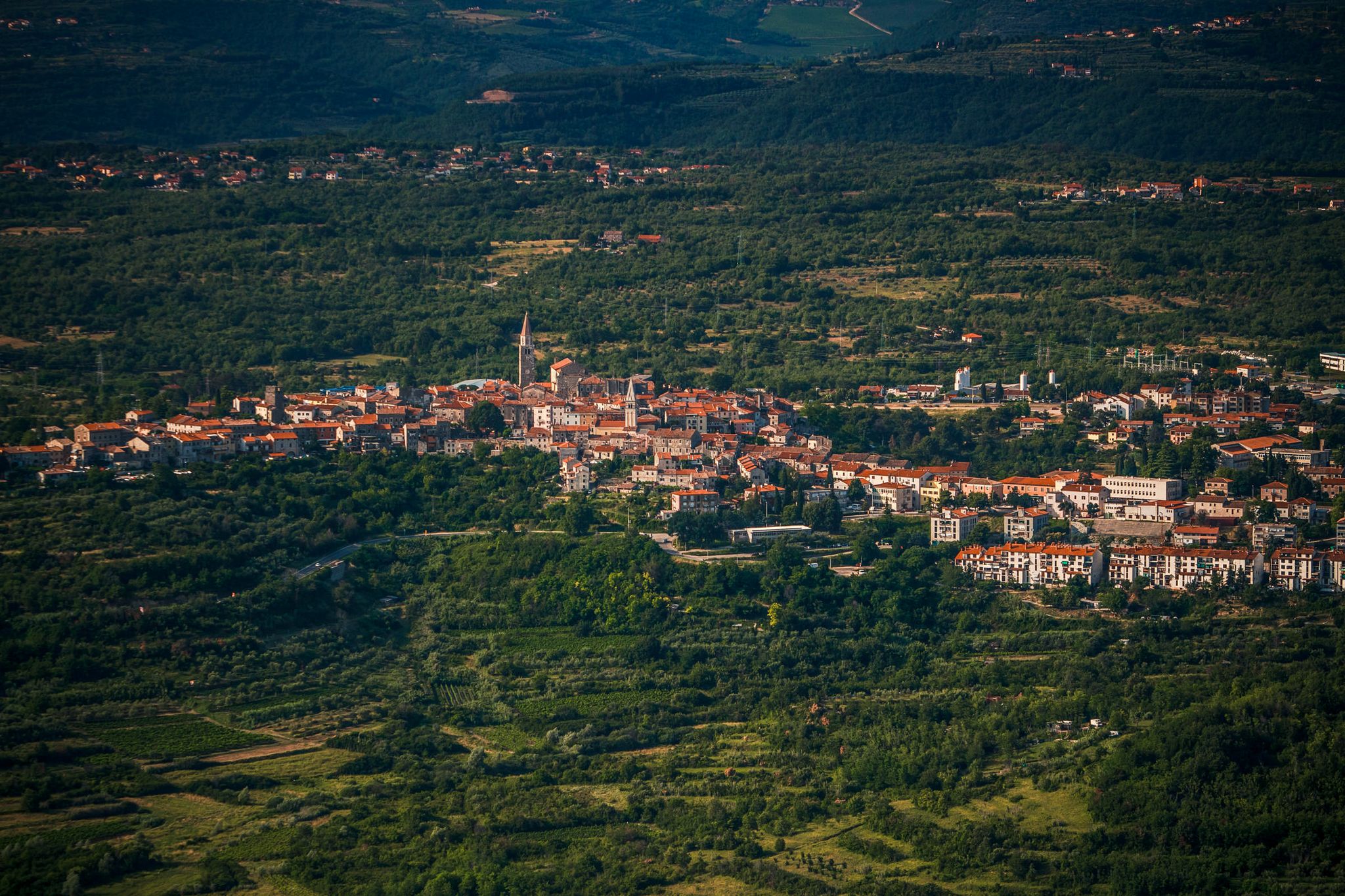
Buje, Istria / Copyright Romulić and Stojčić
Reputable cultural, scientific, pedagogical, and artistic minority institutions have been established in Istria: Italian Drama in Rijeka (Dramma Italiano), Center for Historical Research in Rovinj (Centro di Ricerche Storiche), Italian department at the Faculty of Philosophy and departments in Italian for teacher education at the College of Teacher Education in Pula. Also, La Voce Del Popolo, a daily newspaper in Italian owned by the Italian Union (Unione Italiana), is published in Rijeka.
During his visit to Istria last year, Italian Ambassador to Croatia, Pierfrancesco Sacco, said that Italians in Croatia feel at home, like Croats in Italy. This is especially evident in Istria and Pula, where there are a deep friendship and a desire to find new cooperation methods. On that occasion, the Mayor of Pula, Boris Miletić, said that the fundamental values, which have been nurtured in this area for decades, are openness, multiculturalism, and coexistence.
What language do they speak in Istria?
The vast majority of Istrians speak the Croatian language's Chakavian dialect, meaning they use the interrogative pronoun "ča." Only in some parts near the border with Slovenia, some people use the interrogative pronoun "kaj," so they are often mistaken for Kajkavians. Still, the structure and characteristics of these speeches are distinctly Chakavian.
Chakavian dialect is also spoken in Dalmatia. However, the Istrian Chakavian dialect is different from the Dalmatian one due to the numerous Italianisms. It is also difficult to understand it in the rest of Croatia. The most widespread Chakavian dialect in Istria is the Southwestern Istrian dialect. There are also Buzet, Northern, Central, and Southern Chakavian dialects in Istria.
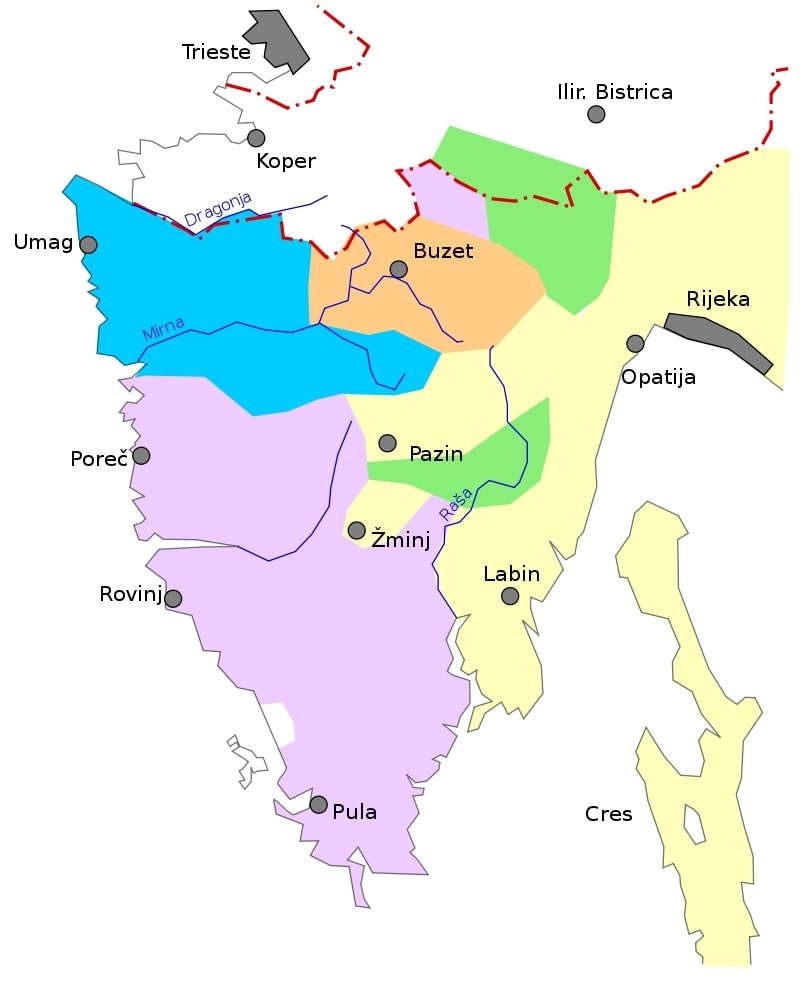
Chakavian dialects in Istria: Southwestern (purple), Buzet (orange), Northern (yellow), Central (green), and Southern Chakavian (blue) / Wikipedia
The aforementioned Italian minority lives in some towns on the Istrian west coast and in some villages near Buje, and they speak Italian. In the Slovenian part of Istria, the Slovenian language is spoken.
In the eastern part of Istria, at the foot of the Ćićarija mountain, in several smaller villages live Istro-Romanians or Ćići, a population of Romanian origin who speak their own Istro-Romanian language, which is a mixture of Romanian and Croatian. Today, many of them have adopted the Croatian language and are now considered Croats.
In addition to the dominant Croatian and Italian languages, other minority languages are spoken in Istria, namely Serbian, Bosnian, Slovenian, Albanian, and Macedonian. One can hear the Shtokavian dialect in Istria as well.
What language do they speak in Istria? Istro-Romanian language
Istria is home to two of the 20 most endangered languages in the world by UNESCO – the Istro-Romanian language and Istriot.

Istro-Romanian language is a Balkan Romance language spoken by only a few hundred people today in the northern Istrian villages of Žejane, Lanišće, and Šušnjevica. It is highly similar to the Romanian language, and for some linguists, the Istro-Romanian language is considered a dialect of Romanian. People in Istria who speak it are called Rumeri, Rumeni, Vlachs, or Istro-Romanians. Croats disparaging started to call them Ćići or Ćiribirci.
In the middle of the 15th century, the Ćiribirci were settled by Ivan VII Frankopan from Velebit on the island of Krk. Since the Ćići plundered Ivan Frankopan in northern Istria in 1463, when their name is first mentioned, it is believed that they immigrated to Istria from Krk. However, Istro-Romanians are not officially recognized as a national minority in Croatia.
The most interesting fact about the Istro-Romanian language is that it was spoken by one of the most famous inventors of all time – Nikola Tesla – even though he wasn't even aware of the ethical existence of the Istro-Romanians. Since elementary school, Tesla was able to speak the Istro-Romanian language, despite the fact that Istro-Romanian was not taught in schools in those years. It was only spoken by a few thousands of people in Istria and Lika, and he could have probably learned it in his family.
Although Telsa always considered himself a Serbo-Croat, one Romanian academic, Professor Moraru, thought Tesla was an Istro-Romanian. When Romanian scholars contacted Tesla in the early 20th century and explained he was of Istro-Romanian roots, he allegedly showed amazement but did not comment on that matter. Therefore, Nikola Tesla has never denied the possibility of his Istro-Romanian origins.
What language do they speak in Istria: Istriot language
Istriot language, often confused with Istro-Romanian language, is a Romance language spoken by about 400 people in the southwestern part of Istria, particularly in Rovinj and Vodnjan. Still, it is also preserved in Bale, Fažana, Galižana, and Šišan. It should not be confused with the Istrian dialect of the Venetian language either.
According to some estimates, the Istriot has only a few dozen active speakers and about 300 people who understand it and can use it in part. It is a Romance language related to the Ladin populations of the Alps, currently only found in Istria. Its classification remained mostly unclear, but in 2017, it was classified with the Dalmatian language in the Dalmatian Romance subgroup.
Historically, its speakers never referred to it as "Istriot language." Instead, it had six names after the six towns where it was spoken: in Vodnjan it was named "Bumbaro," in Bale "Vallese," in Rovinj "Rovignese," in Šišan "Sissanese," in Fažana "Fasanese," and in Galižana "Gallesanese." The term Istriot was coined by the 19th-century Italian linguist Graziadio Isaia Ascoli.
Younger Italians in these places mostly understand Istriot, but they rarely use it, and Croats rule this idiom very badly or not at all. It is most endangered in Fažana, and it seems that it is most strongly maintained in Bale.
What language do they speak in Istria: Istrian dialect in Slovenia
Slovene dialects are separated into a few groups, and the Istrian dialect, spoken in Slovene Istria, falls in the Littoral dialect group. Istrian dialect is spoken in the rural areas of Koper, Izola, and Piran. The Slovenes living in the Italian municipalities of Muggia and San Dorligo della Valle, as well as in the southern suburbs of Trieste (Servola, Cattinara). In Croatia, it is also called the Slovenian-Istrian dialect.
The dialect has been influenced by Croatian as spoken in Buzet and Ćićarija and is further subdivided into the Rižana and Šavrin Hills subdialects.
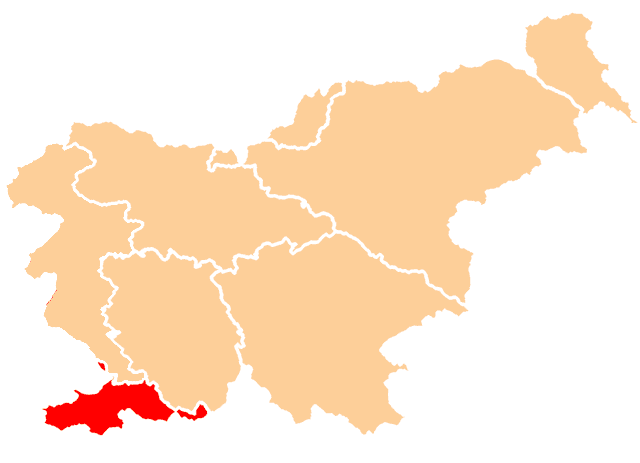
Slovene Istria / Wikipedia
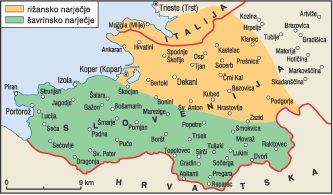
Rižana subdialect (yellow) and Šavrin Hills subdialect (green) / Wikipedia
The Rižana subdialect is spoken in the northern part of Slovenian Istria, in the Rižana Valley east and north of Koper, including the settlements of Bertoki, Dekani, Osp, Črni Kal, Presnica, Podgorje, and Zazid. In Italy, Rižana subdialect is spoken in most of the municipalities of San Dorligo della Valle and Muggia south of Trieste and some southern suburbs of Trieste, especially Servola.
The Šavrin Hills subdialect is spoken in the Šavrin Hills south of a line from Koper to the south of Zazid. It includes the settlements of Koper, Izola, Portorož, Sečovlje, Šmarje, Sočerga, and Rakitovec.
The mixture of Šavrin dialects proves the closeness to the Čakavian dialects, and the Rižana sub-dialect is entirely Slovene. There are many Romance loanwords in both sub-dialects linguistic legacy, mostly Venetian, Trieste-Romance, and Italian.
Why do locals speak Italian?
As previously explained in the second paragraph of this article, Croatians in Istria speak Italian because it has been implemented in public speech and institutions for such a long time.
As Marija Črnac Rocco, head of the Rovinj City Council office, explained for Novosti portal, the Italian national minority in Istria (and certain other Croatian parts) is autochthonous, meaning that the Italian component has always lived and existed in these territories.
Likewise, Italian was the official language during all the various reigns in Istria until the end of the Second World War – the Venetian Republic, the Kingdom of Austria, Napoleon's rule, the Austro-Hungarian Monarchy, and the Kingdom of Italy.
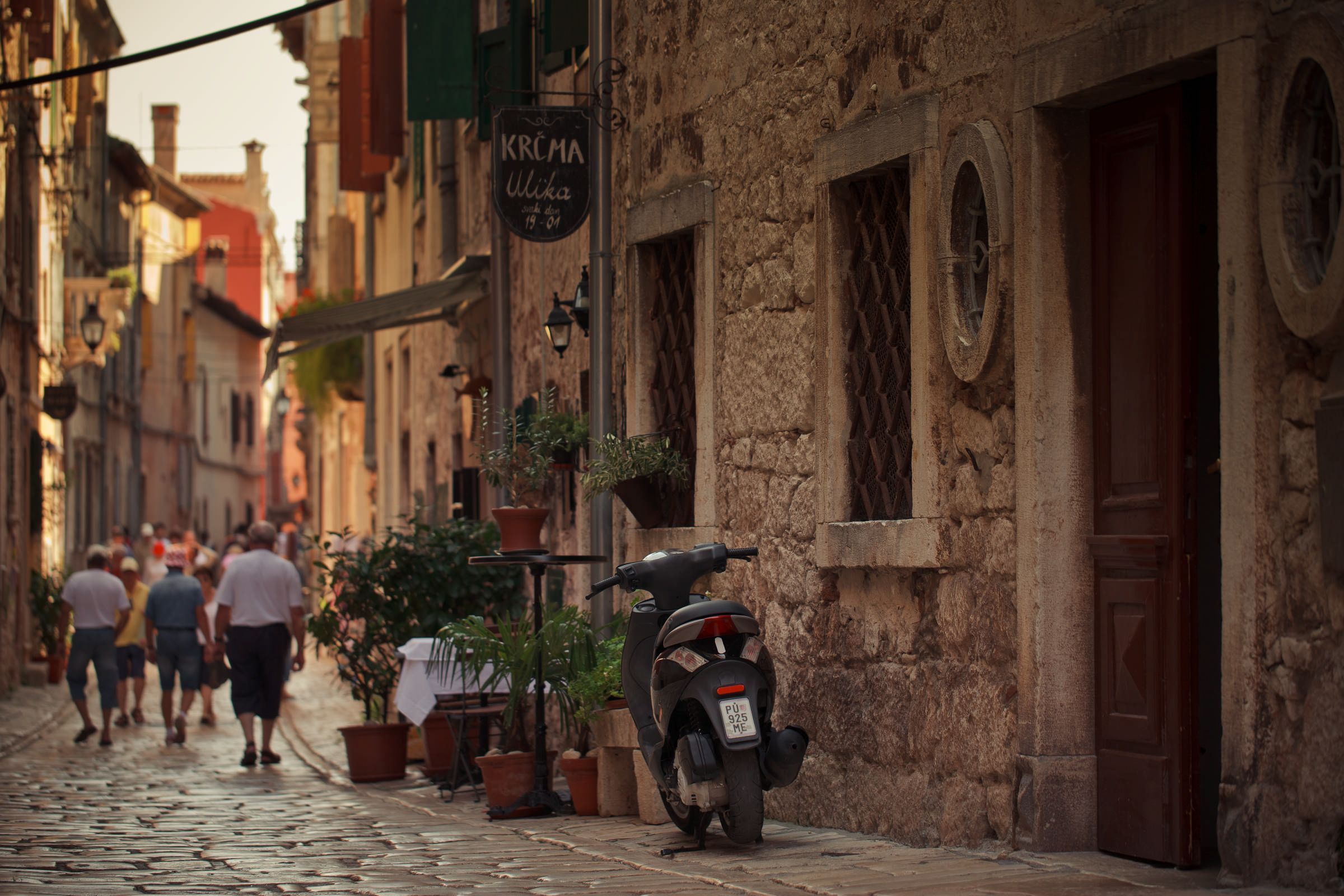
Rovinj, Istria / Copyright Romulić and Stojčić
After the Second World War, Istria was annexed to the Federal Republic of Slovenia and Federal Republic of Croatia, namely the Socialist Federal Republic of Yugoslavia. The Italian national community's position, which became a minority in a significant part of Istria due to sad post-war circumstances, has been the subject of consideration and securing the rights of many international agreements.
Therefore, the equal use of the Croatian and Italian languages in Istrian County and many towns and municipalities in Istria is undoubtedly a legal obligation, which for most Istrians is both a moral duty and a civilizational achievement of which they are proud.
Bilingualism in Istria is not only lived in translated official documents, it is lived in families, on the street, in everyday communication, in traditions, and customs. Bilingualism in Istria is natural, spontaneous, and it is perceived as an advantage and a richness.
Istria in Italian and Croatian: some important bilingual place names
Istrian County has ten cities and 31 municipalities. When you drive through Istria, you will notice bilingual traffic signs, including both Croatian and Italian names of towns and municipalities, such as:
- Buje – Buie
- Buzet – Pinguente
- Fažana – Fasana
- Grožnjan – Grisignana
- Labin – Albona
- Medulin – Medolino
- Motovun – Montona
- Novigrad – Cittanova (d'Istria)
- Pazin – Pisino
- Poreč – Parenzo
- Pula – Pola
- Rovinj – Rovigno
- Umag – Umago
- Višnjan – Visignano
- Vodnjan – Dignano
- Vrsar – Orsera
- Žminj – Gimino
As such, in Croatian, we say Istra, and Italians say Istria.
When was Istria a part of Italy?
Istria was a part of the Kingdom of Italy after the First World War when the Austro-Hungarian Empire disintegrated. In 1920, with the Rapallo Peace Treaty, Istria, the Croatian city of Zadar, as well as the islands of Lastovo, Cres, and Lošinj, belonged to Italy. Rijeka belonged to Italy in 1924. During the Second World War, the population organized a movement of resistance to fascism by Benito Mussolini. Therefore, after the war, Istria became part of Yugoslavia, where it remained until its disintegration in the early 1990s when the Istrian peninsula was divided by Croatia and Slovenia.
During the 19th and the first half of the 20th century, a significant Italian linguistic and ethnic community in Croatia mainly concentrated on the west coast of Istria and in Rijeka, Dalmatian, and Kvarner towns. After the First and especially after the Second World War, most Croatian Italians emigrated to Italy.
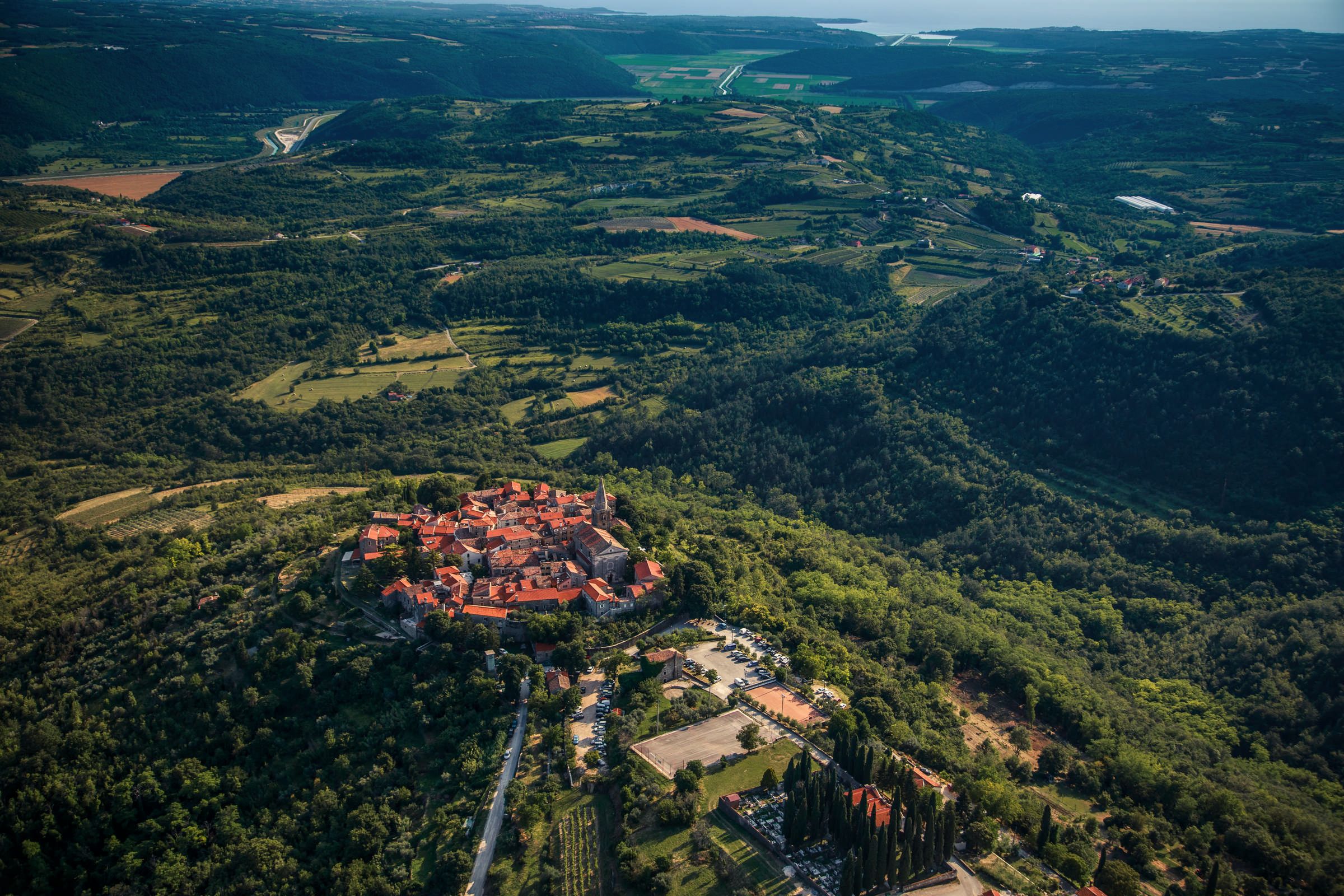
Grožnjan / Copyright Romulić and Stojčić
Today, almost three-quarters of all Italians in Croatia live in Istria County. The only municipality in Croatia where Italians make up a relative majority is Grožnjan in Istria, with 39.4 percent ethnic Italians in the population and 56 percent of the people whose mother language is Italian.
The Italian community's position and rights are guaranteed by the Constitutional Law on Human Rights and the Rights of Ethnic and National Communities of the Republic of Croatia, as well as various international agreements and treaties.
To follow the People Also Ask Google about Croatia series, click here.



